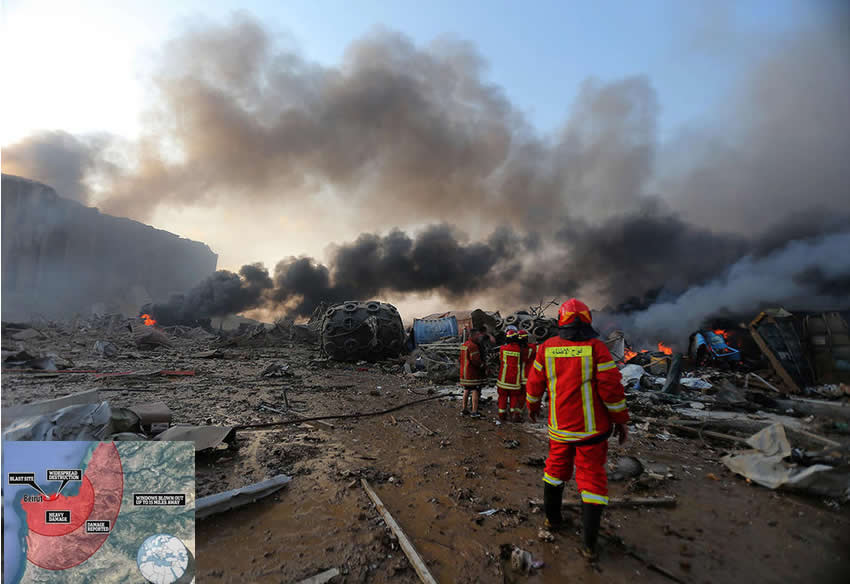
Explosives cause eminent and serious threat on Structures, Structure Foundation, and Infrastructure. Despite structures can be designed to withstand dynamic and blast impact and blast wind associated with explosives, yet, uncertainties and variables often associated with explosions and blasts pause threat on structures and foundations as exact impact predictions are not possible.
The effect and intensity of a blast is correlated to four main parameters.
- Boundary conditions. An example is recent August 4th, 2020 explosion in Beirut where boundary conditions (open space towards the sea on one side of the blast) resulted in saving the city from total destruction. Read about Beirut’s catastrophic blast
- The equivalent of the exploding material to an explosion of a TNT material. Many explosions result from detonation of chemical or other material and the weight of the exploded material is multiplied by a factor to determine the equivalent weight of TNT material that when exploded will cause similar damage, impact, and blast wind. As there are many parameters associated with an explosion, these multiplication factors are often debatable. There are also environmental impacts resulting from detonation of chemicals that is not matched with a detonation of TNT material
- Weight of the exploding material
- Distance between the blast and the affected structures and elevations
Blasts may cause different type of structure damages. Damage levels of a blast is usually categorized by side-on overpressure values being from Light Damage (LD) to Total Destruction (TD). Damages can be determined by visual inspection such as cracks, breaks, cuts, etc and the structure behavior such as deflections and deformed shapes. Some other damages are future indirect damages resulting from an adjacent structure damage or a damaged buried foundation with unpredictable behavior. There are also progressive failures (domino failures) that may occur after the blast causing more damage and injuries. Often, structures are examined by experts to determine their condition and whether demolition or repairs are possible and required.
Blasts can result in window and door damages, column damages, bending of slabs, roof crumbles, and wall failures. Foundations can be damaged by breaks, displacements, tension and shear failures. It remains the inelastic deformation that causes a long term damage causing propagating cracks on structural elements.
Challenges dominate the design of high rise structures against blasts and dynamic impacts. Knowing high rise structures tend to trap the energy resulting from a blast, it is important any design take into consideration the following factors:
- Proper understanding of the geotechnical underground and resistance of soil against dynamic loads
- Layout, dimension, and embedment of the foundation.
- Shape of a structure in consideration to airflow (blast wind) management
- Mass of the foundation and the structure
- Tensile load and shear resistance of foundation and structure elements.
- Elastic Deformation allowances and inelastic deformation consideration based on material properties
- Stiffening elements and load distribution at time of impact
Blasts may also cause severe underground damage to existing infrastructure and networks in addition to changes in the soil parameters and characteristics. Often, soil improvements and treatments are required at the location of the blast and at damaged surroundings. As an example, the recent Beirut August 4th 2020 Port explosion resulted in a hole 48 meters deep. The type of exploded material can also cause an environmental threat to the underground and underground water resources. Underground networks can get displaced at joints, cracked, damaged, or totally destroyed. Damages to water and gas pipes can cause long term losses and life threats in addition to damages in sewer networks causing potential environmental and safety hazards and threats.
The team at bætin earth technologies is experienced in evaluating the effect and assessing the risk of blasts and explosions on foundations and the underground in addition to addressing such design requirements in geotechnical applications and structures. Geotechnical and foundation designs are performed based on latest international standards and common practice.
